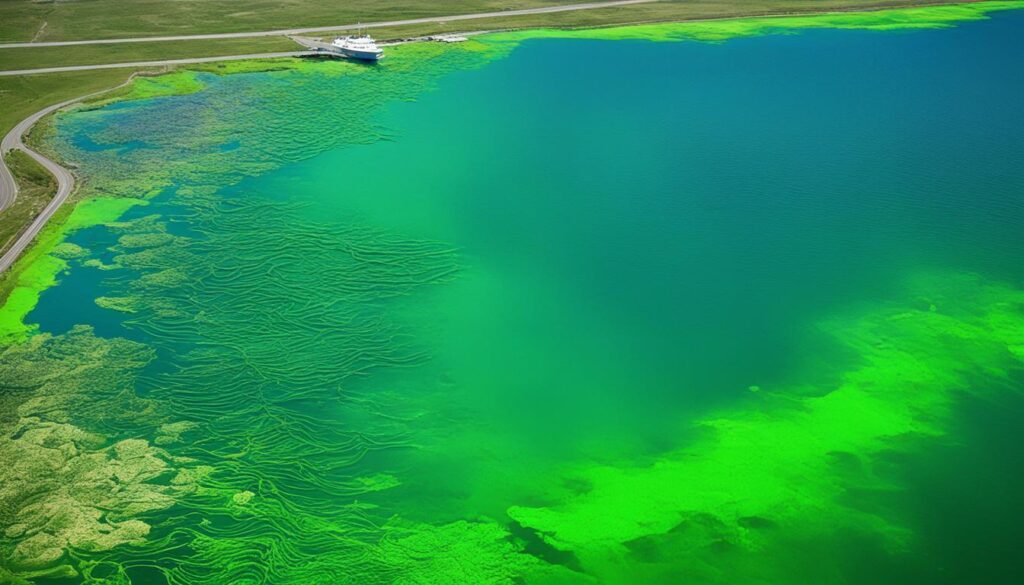Algal blooms, particularly in aquatic environments, have become a significant area of study for ecologists and marine biologists. These blooms involve the rapid increase or accumulation of algae, which harness energy through photosynthesis. While many of these algal concentrations are microscopic and harmless, some can produce potent toxins posing serious threats to marine life, ecosystems, and human health.
Understanding algal blooms requires comprehensive research. Organizations like the National Institute of Environmental Health Sciences (NIEHS) and the National Oceanic and Atmospheric Administration (NOAA) focus on studying the formation, triggers, and broader impacts of harmful algal blooms (HABs). Climate change is expected to further influence the patterns of these blooms, making continuous monitoring and preventative strategies essential.
Key Takeaways
- Algal blooms occur in various aquatic environments.
- These blooms utilize photosynthesis for energy production.
- Not all algal blooms are harmful, but some produce dangerous toxins.
- Impacts include risks to marine life, ecosystems, and human health.
- Organizations like NIEHS and NOAA are pivotal in algal bloom research and management.
- Climate change could potentially alter the frequency and severity of algal blooms.
Introduction to Algal Blooms
Algal blooms are overgrowths of algae visible to the naked eye, often appearing in various colors depending on the algal species involved. These blooms can have significant impacts on marine environments, some of which can be harmful to both marine life and humans.
Definition and Overview
A specific type of algal bloom, known as harmful algal blooms (HABs), occurs when toxin-producing algae, such as cyanobacteria, proliferate extensively. These HABs release toxins detrimental to human health, wildlife, and the environment. Numerous environmental factors like temperature, nutrient availability, and water quality contribute to the development of HABs.
Importance in Marine Ecosystems
In marine ecosystems, algae play a pivotal role by forming the base of the food web and contributing to biodiversity. However, when the balance is disrupted, HABs emerge, posing a threat to the health and stability of marine environments. The toxin production from these blooms can gravely affect the myriad species that depend on these ecosystems.
What Causes Algal Blooms?
The genesis of algal blooms is tied to a blend of biological and environmental conditions. A dominant trigger factor is the presence of elevated temperatures, which provide a fertile environment for algal growth. Additionally, abundant nutrients, often resulting from nutrient runoff associated with fertilizers and sewage, significantly contribute to the rapid proliferation of algae.
Environmental research points to the specific combinations of salinity and pH levels that can foster these blooms. Moreover, climate change plays a pivotal role by altering climate patterns, leading to rising global temperatures, which in turn increase the frequency and intensity of harmful algal blooms (HABs). Scientists are tirelessly working to understand these complex trigger factors in greater depth. This enhanced understanding will ultimately help predict and manage algal blooms more effectively, mitigating their impact on marine ecosystems and human health.
Types of Algal Blooms
Algal blooms can be classified into two main categories: harmful and non-harmful. Understanding these distinctions is crucial for comprehending their ecological impact.
Harmful vs. Non-Harmful Blooms
Harmful algal blooms (HABs) are notorious for their negative effects on marine biodiversity and human health. These blooms often involve a variety of organisms, including phytoplankton and cyanobacteria, that can produce toxins detrimental to marine wildlife and ecosystems. Conversely, non-harmful blooms do not generate toxins but can still disrupt local ecological balance due to excessive growth.
Indicators of Algal Blooms
Identifying the presence of algal blooms is essential for managing their potential ecological impact. Common indicators include water discoloration and the formation of scum on the water’s surface. Specific types of phytoplankton such as dinoflagellates and diatoms are often responsible for HABs in marine environments. In freshwater, cyanobacteria are frequently the culprits. These blooms can create dormant cysts or exhibit rapid surface growth, making detection and control challenging.
| Factor | Harmful Algal Blooms (HABs) | Non-Harmful Blooms |
|---|---|---|
| Toxins | Yes | No |
| Effect on Biodiversity | Negative | Neutral/Potentially Disruptive |
| Common Organisms | Dinoflagellates, Diatoms, Cyanobacteria | Various algae without harmful toxin production |
Impact on Marine Pollution
Algal blooms significantly contribute to marine pollution, causing ecosystem disruption and harming overall aquatic health. As the masses of algae decay, this process leads to oxygen depletion, creating hypoxic or anoxic conditions detrimental to marine life. Such environments often result in substantial mortality among marine organisms.
Moreover, harmful algal blooms (HABs) impair water clarity and quality, obstructing light penetration and thereby hindering photosynthesis for plants located in deeper waters. This disruption in photosynthesis and subsequent oxygen depletion further affects the species composition and leads to shifts in marine biodiversity.
The economic implications of algal blooms are profound, impacting commercial fisheries, recreational water activities, and the health of critical species such as coral reefs and submerged aquatic vegetation. These ecological and financial repercussions highlight the necessity for greater focus on mitigating HABs and addressing the root causes of this growing issue.
| Impact Description | Resulting Issues |
|---|---|
| Ecosystem Disruption | Destabilized marine habitats |
| Aquatic Health Decline | Decreased biodiversity and marine mortality |
| Algae Decay | Oxygen depletion leading to hypoxic conditions |
| Oxygen Depletion | Increased mortality of marine species |
The Role of Climate Change
Climate change, a significant modern-day issue, is radically reshaping our global environment. This includes its intricate connection with the rise in frequency and intensity of algal blooms.
Warming Water Temperatures
A prominent aspect of global warming lies in the consistent increase in water temperatures. This warming phenomenon serves as a prime catalyst for more frequent and severe algal blooms. Warm water temperatures create ideal conditions for certain algal species to thrive, making it an essential factor in understanding algal adaptations in a rapidly changing climate.
Increased Frequency and Severity
As climate research progresses, it becomes evident that the changing climate not only favors the growth of harmful algal species but also expands the habitats susceptible to these blooms. The result is an uptick in occurrences in previously unaffected regions and more intensified seasonal impacts on marine ecosystems. These environmental stressors highlight the pressing need for continued and focused climate research to mitigate the growing threat of algal blooms worldwide.
Human Health Risks from Harmful Algal Blooms
Harmful algal blooms (HABs) present several health risks to humans, primarily through toxic exposure to environmental toxins. These health risks can occur in various ways, including the ingestion of contaminated seafood, direct contact with water housing the blooms, or even inhalation of airborne toxins. Immediate health impacts from HAB-related toxic exposure range from mild symptoms such as nausea and vomiting to more severe consequences like neurological impairments and liver damage.

Certain populations, including children, the elderly, and individuals with pre-existing health conditions, are particularly susceptible to the effects of environmental toxins associated with harmful algal blooms. Communities heavily reliant on seafood for their diet face an increased risk, underscoring the importance of seafood safety initiatives.
To mitigate these risks, awareness and adherence to public health advisories are essential. These advisories often recommend limiting exposure to contaminated water and ensuring seafood safety through rigorous testing and monitoring. These measures are crucial for public health, helping prevent potential outbreaks of illnesses linked to harmful algal blooms.
| Health Impact | Symptom | Risk Group |
|---|---|---|
| Acute Illness | Nausea, Vomiting | General Population |
| Neurological Impairments | Confusion, Memory Loss | Elderly, Those with Pre-existing Conditions |
| Liver Damage | Abdominal Pain, Jaundice | Children, Seafood-dependent Communities |
Impact on Marine Ecosystems
The presence of harmful algal blooms (HABs) in marine ecosystems can have devastating consequences. These blooms often lead to hypoxia, a condition characterized by low oxygen levels, which severely impacts marine life and ecosystems.
Oxygen Depletion and Marine Life
Hypoxia, caused by the excessive growth of algae, can lead to widespread fish kills as oxygen levels drop too low to support most marine organisms. This oxygen depletion creates dead zones, rendering large areas uninhabitable for aquatic life. Furthermore, algal overgrowth blocks sunlight, which is essential for underwater vegetation and corals. This blockage can trigger coral bleaching, weakening the overall health and diversity of coral reefs. The resulting damage compromises the resilience of marine ecosystems and depletes biodiversity.
Economic Impact on Fisheries
The economic impact of HABs on fisheries can be severe. Blossoming algae can lead to temporary or long-term closures of fisheries, causing significant commercial revenue loss for businesses and communities reliant on fishing. This disruption affects the broader economy as well, including tourism and recreational activities that depend on healthy marine environments.
| Impact | Detail |
|---|---|
| Hypoxia | Oxygen levels fall, leading to dead zones and fish kills. |
| Coral Bleaching | Algal overgrowth blocks sunlight, impacting coral health. |
| Commercial Revenue Loss | Fishery closures and decreased tourism disrupt local economies. |
Impact on Coastal Erosion
Understanding the impact of algal blooms on coastal erosion is crucial. As algal blooms decompose, they create hypoxic conditions that harm aquatic vegetation. This leads to habitat damage and impedes the growth of plants that anchor sediment, contributing to sediment disruption.
Such plants, including seagrass meadows, are vital for shoreline protection. Their decline makes coastal areas more vulnerable to erosion from natural forces like waves and currents. Additionally, the loss of these habitats affects infrastructure and ecosystems, further emphasizing the importance of preserving aquatic vegetation.
| Factor | Impact | Consequence |
|---|---|---|
| Habitat Damage | Loss of vegetation | Increased erosion susceptibility |
| Sediment Disruption | Unstable sediments | Coastal erosion amplification |
| Shoreline Protection | Reduced buffering capacity | Greater infrastructure risk |
| Aquatic Vegetation | Hypoxic conditions | Decreased plant growth |
Efforts to Monitor and Control Algal Blooms
The management of algal blooms is a critical aspect of environmental management, relying on advanced detection, prediction, and control methodologies. Evolving detection techniques have greatly improved our ability to monitor these phenomena, such as the Environmental Sample Processor, offering real-time data on the presence of harmful algal blooms (HABs). This technology plays a vital role in safeguarding public safety by providing timely and accurate information.
Detection Techniques
Detection techniques for algal blooms have significantly advanced over the years. Instruments like the Environmental Sample Processor deliver essential data on HAB presence, allowing for prompt responsive actions. Additionally, satellite imagery and remote sensing tools have been incorporated to enhance the scope and effectiveness of bloom detection, ensuring a comprehensive approach to environmental management.
Prediction and Monitoring
Prediction and monitoring capabilities have been bolstered by initiatives such as the National Oceanic and Atmospheric Administration (NOAA)’s Harmful Algal Bloom Monitoring System. This system utilizes a combination of satellite imagery, buoy data, and predictive models to deliver crucial information to coastal managers. These forecasting systems are continuously being refined to improve their accuracy and timeliness, thereby enhancing the ability to anticipate and respond to algal blooms effectively.
Control Methods
While detection and prediction are key, control methods are equally important in mitigating the impacts of algal blooms. Various strategies are under investigation, ranging from clay dispersal techniques to the use of nanobubble aeration. These interventions aim to provide sustainable solutions that minimize the environmental impact while protecting public health and marine ecosystems. The goal is to develop effective bloom interventions that can be readily deployed to reduce the frequency and severity of HABs, thus ensuring public safety.











